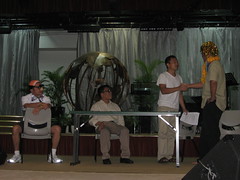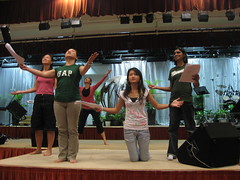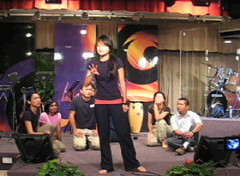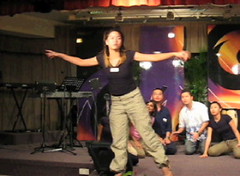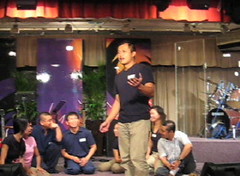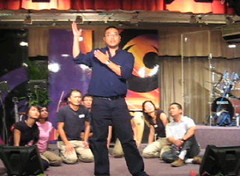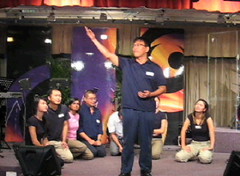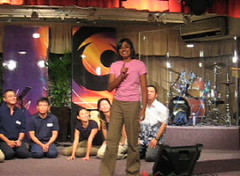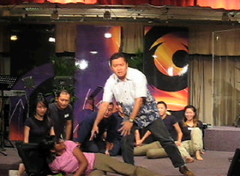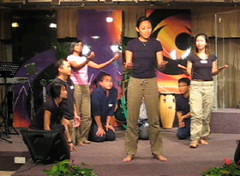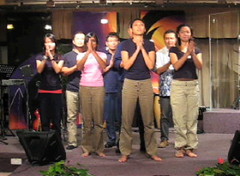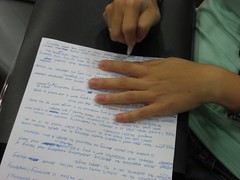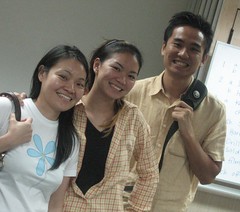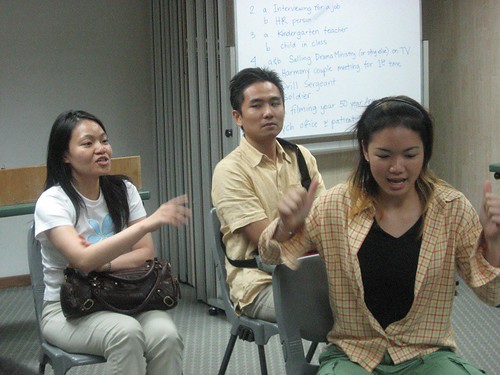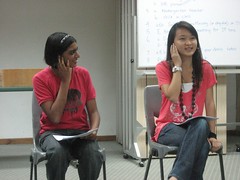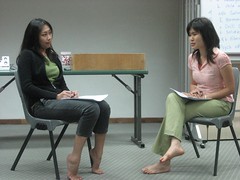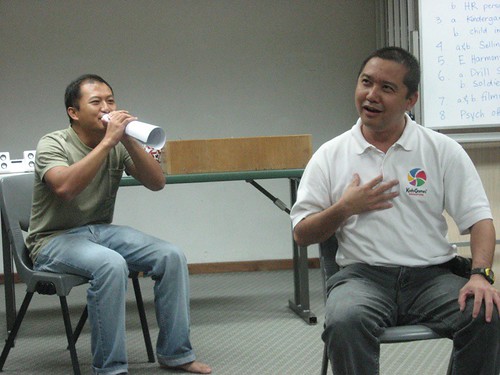Tapestry Fluid Sculpture demonstration:
Wednesday, December 06, 2006
Sunday, December 03, 2006
Wednesday, November 22, 2006
"Four Better or Four Worse"
lesson learned: practice with the props! Great job guys! What team work.
Tuesday, November 21, 2006
COURSE EVALUATION - STRETCH YOUR MEMORY
Customer Survey Reports: This Customer’s Satisfaction is _____%!
These last 14 weeks…
I can’t believe you got me to try
I will never forget the lesson about
If you get to teach this course again don't forget to include ____________ (ie. information, helpful tips, style, advice, attitude)
I really want to work more on
I wish we’d had more time for
I hope I never have to _________________ again!
I was moved by
I sensed God’s presence when
I also have this to say
How can I pray for you?
May the God of peace, who…brought back from the dead our Lord Jesus…
equip you with everything good for doing his will, and may he work in us what is pleasing to him, through Jesus Christ. Hebrews 13:20,21
It's been my priviledge to be your teacher. See you soon!
Customer Survey Reports: This Customer’s Satisfaction is _____%!
These last 14 weeks…
I can’t believe you got me to try
I will never forget the lesson about
If you get to teach this course again don't forget to include ____________ (ie. information, helpful tips, style, advice, attitude)
I really want to work more on
I wish we’d had more time for
I hope I never have to _________________ again!
I was moved by
I sensed God’s presence when
I also have this to say
How can I pray for you?
May the God of peace, who…brought back from the dead our Lord Jesus…
equip you with everything good for doing his will, and may he work in us what is pleasing to him, through Jesus Christ. Hebrews 13:20,21
It's been my priviledge to be your teacher. See you soon!
Tuesday, November 07, 2006
Here's a link to a dance we didn't watch last night in class. The rehearsal to a dance by Singaporean believers. The song is ARMS OF AN ANGEL. I think you'll really like it.
I was sooo stressed out planning for this class. It didn't seem like anything was coming together. You have seen my demonstrations of my dance ability last night (the BUNNY HOP!) So, I'm sure you know why giving you and evening of dance overview caused fear and trepidation! I wasn't finding much of worth on YouTube, people I'd asked for help weren't available, didn't get back to me or gave me video tapes (my vcr is broken) or vcd's that wouldn't play. After surfing and reading and calling and reasearching and making copies of wikipedia info, and running around town, an hour before class I was wondering what was going to happen... But then, it all worked out!
Jaqueline showed up with a dvd and pitched in with input and demonstrations.
We watched her video from 2004 Dance Collective (a variety of styles and ability), and saw some of the highlights I'd found on YouTube (my favourite was Mustard Seeds 10th Anniversary). Come next week to meet Elaine Chan (you saw her dance in that improv dance from Dance Collective) and hear from her about her philosophy of dance as ministry.
Next week:
Preparing for our final night
Here are your options from the syllabus:
1. An in class performance of an original piece that can somehow be used in ministry (up to 8 minutes, and may be done in a group of up to 3 people). Part of your presentation is to explain how you would use it and why you chose it!
Printed draft of your script due: 14 November.
Work in progress performance on 21 November
2. An oral and creative presentation of the content of one of the chapters from the selected reading list (minimum 5 minutes) Draft of script due: 14 November
3. A written reaction paper to an entire book from the selected reading list.
Due: 21 November
Say, class...why don't you post a comment below to let us know what is brewing for you?
Preparing for our final night
Here are your options from the syllabus:
1. An in class performance of an original piece that can somehow be used in ministry (up to 8 minutes, and may be done in a group of up to 3 people). Part of your presentation is to explain how you would use it and why you chose it!
Printed draft of your script due: 14 November.
Work in progress performance on 21 November
2. An oral and creative presentation of the content of one of the chapters from the selected reading list (minimum 5 minutes) Draft of script due: 14 November
3. A written reaction paper to an entire book from the selected reading list.
Due: 21 November
Say, class...why don't you post a comment below to let us know what is brewing for you?
Quiz 3: Playback Theatre & Reader’s Theatre
NOTE: There are no “correct answers” for these exercises. It’s just an opportunity for you to show that you’ve learned about using these 2 forms, and give you a chance to be creative. AND share your inspiration in a way we can share with others. Post your answers as comments to the following entries. I suggest you first type it out as a document on your own computer and save it before pasting it as a comment in the class blog.
PART I: Playback Theatre
1. You are the “conductor” for an evening of playback theatre and the topic is:
“The Body: Celebrating what Fellowship Among Followers of Jesus Can Be.”
What might you do to help warm up the group (audience and players) to this theme and get them more ready to start sharing their stories?
2. After some kind of warm up, you want to start with some “short forms.” You tell the group one of your own favourite stories of how someone built you up or ministered to you. Then you ask them to remember a time when another Christian was truly the hands or feet of Christ to them. One person, Joseph, volunteers this information: “When I was out of a job, someone in my cell group helped me get a new position.” You probe and Joseph isn’t willing to share much else except that this person was generous with time and expertise. Gave Joseph a boost of confidence. You ask a few more questions to probe “Do you want to share the name of this person?” “Is there anything else about their helping you that you want to share?” “How did their help make you feel?” He gives you short answers, and there isn’t much of a story in what he shares.
What short form would you suggest the actors use?
Describe how you imagine it played out.
What short form would you suggest the actors use?
Describe how you imagine it played out.
3. The next person who shares is Lucy. It’s easy to get her to talk. With very few questions, she tells about a time when she was housebound on evenings & weekends caring for an elderly parent who was ill. You find out that she is a single mother and eventually, when the mum was invalid, she had to take leave because there was no maid to help the family. On the 3rd week of not being able to attend cell group or church, the cg came to her house bringing groceries. She was embarassed that her place was such a mess and that some of them had to sit on the floor. But they didn’t seem to mind. One of the guys fixed her home computer/internet connection and showed her how to shop online for groceries. The 4th week someone came early to help clean the apartment and mop the floor. Another guy in the group bought a CD of songs he thought would encourage her during the week. The group met at her house for 4 months until the mother passed on, and then they helped with planning the funeral/etc.
Which “long form” would you use. Describe a way it could be played out by 4 actors.
Which “long form” would you use. Describe a way it could be played out by 4 actors.
QUIZ 3 PART II: Reader’s Theatre
Break down ONE of the following text as a reader’s theatre script. You can write in your own text as an intro, or closing how you see fit. Be creative!
Reader’s Theatre Option #1:
Prayer of Detachment
St. John of the Cross (1542-1591)
Deliver me, O Jesus...
...from the desire of being loved
...from the desire of being extolled
...from the desire of being praised
...from the desire of being preferred
...from the desire of being consulted
...from the desire of being approved
...from the desire of being popular
Deliver me, O Jesus...
...from the fear of being humiliated
...from the fear of being despised
...from the fear of suffering rebuke
...from the fear of being forgotten
...from the fear of being wronged
...from the fear of being ridiculed
...from the fear that others may be loved more than I
Jesus, grant me the grace to desire...
...that others may be esteemed more than I
...that in the opinion of the world others may increase and I may decrease
...that others may be chosen and I set aside
...that others may be praised and I unnoticed
...that others may become holier than I provided that I may become as holy as I should.
NOTE: If you choose to work on this one, copy the text above and break it down as a Readers' Theatre. You can do this first in word processing document on your computer (to save it this way) and then paste it in as a comment here once you've finished.
Reader’s Theatre Option #2
In Praise of Dancing
St. Augustine
I praise the dance, for it frees people
from the heaviness of matter and binds
the isolated to community.
I praise the dance, which demands everything:
health and a clear spirit and a buoyant soul.
Dance is a transformation of space, of time, of people,
who are in constant danger of becoming all brain,
will, or feeling.
Dancing demands a whole person, one who is
firmly anchored in the center of his life, who is
not obsessed by lust for people and things
and the demon of isolation in his own ego.
Dancing demands a freed person, one who vibrates
with the equipoise of all his powers.
I praise the dance.
O man, learn to dance, or else the angels in heaven
will not know what to do with you.
NOTE: If you choose to work on this one, copy the text above and break it down as a Readers' Theatre. You can do this first in word processing document on your computer (to save it this way) and then paste it in as a comment here once you've finished.
In Praise of Dancing
St. Augustine
I praise the dance, for it frees people
from the heaviness of matter and binds
the isolated to community.
I praise the dance, which demands everything:
health and a clear spirit and a buoyant soul.
Dance is a transformation of space, of time, of people,
who are in constant danger of becoming all brain,
will, or feeling.
Dancing demands a whole person, one who is
firmly anchored in the center of his life, who is
not obsessed by lust for people and things
and the demon of isolation in his own ego.
Dancing demands a freed person, one who vibrates
with the equipoise of all his powers.
I praise the dance.
O man, learn to dance, or else the angels in heaven
will not know what to do with you.
NOTE: If you choose to work on this one, copy the text above and break it down as a Readers' Theatre. You can do this first in word processing document on your computer (to save it this way) and then paste it in as a comment here once you've finished.
Dance as Ministry
Links from a dance ministry leader in USA - Evelyn Okamoto
Celebration of Dance
This link is to a ministry that has videos and shows clips on their website.
Using American Sign Language
This link isn't a dance link, but is a useful resource for movement ideas. Limited, but great since it shows a video clip as well as the verbal description.
This one has loads of training & networking resources for Christian dance.
Wonderful quotes Evelyn has collected and passed on to us:
“A dance is a very profound means to integrate the internal world with the external world.” Bill T. Jones, dancer/choreographer
“…the poetry of dance is the expression of unseen spiritual grace.”
Stewart Headler (19th century)
“The art of dancing…perhaps more than all other arts, is an outward and visible sign of an inward and spiritual grace.”
Ruth St. Denis, pioneer of modern dance, founder Sacred Dance Guild
“No, art is not catharsis. Just the opposite: Art is rehearsal. Watching or listening to other people do something is a way of mentally rehearsing it—which makes it easier for us to do the same thing. After all, that’s why businesses spend untold millions of dollars on advertising every year.” Chuck Colson, founder, Prison Fellowship
“Art enables us to find ourselves and lose ourselves at the same time.”
Thomas Merton, Trappist monk, writer
“Art takes the ordinary and alters it in ways which make us see a deeper reality, one of things not merely seen but both implied and inferred. It alters relationships and makes us move off our comfortable center, to see, hear and think anew. Art can, in the hands of great talent, make beauty which reverberates through our lives and carries us into rarified strata. It can shatter our perceptions. It can clarify our anger. It can help us to understand our sorrow…Art provides the channel for those qualities which endure beyond the turmoil of a chaotic and threatened world…In dance, one returns to long forgotten basics: the revelations of non-verbal symbology – the physical knowledge of emotion. The body has been learning since before birth.”
Bella Lewitzky, dancer/choreographer
“I scrub my hands with the purest soap, then join hands with the others in the great circle dancing around your altar, God, Singing God-songs at the top of my lungs, telling God-stories.” David, song writer, king (Psalm 26)
“Therefore, I urge you, brothers, in view of God’s mercy, to offer your bodies as living sacrifices, holy and pleasing to God—which is your spiritual worship.”
Romans 12:1 (NIV)
“So here’s what I want you to do, God helping you: Take your everyday, ordinary life—your sleeping, eating, going-to-work, and walking-around life – and place it before God as an offering. Embracing what God does for you is the best thing you can do for him.”
Romans 12:1 (The Message)
“The very moment you separate body and spirit, you end up with a corpse. Separate faith and works and you get the same thing: a corpse.”
James 2:26 (The Message)
“Beauty is not only a terrible thing, it is also a mysterious thing. There God and the Devil strive for mastery, and the battleground is the heart of men.”
Fyodor Dostoyevsky, novelist (The Brothers Karamazov)
Links from a dance ministry leader in USA - Evelyn Okamoto
Celebration of Dance
This link is to a ministry that has videos and shows clips on their website.
Using American Sign Language
This link isn't a dance link, but is a useful resource for movement ideas. Limited, but great since it shows a video clip as well as the verbal description.
This one has loads of training & networking resources for Christian dance.
Wonderful quotes Evelyn has collected and passed on to us:
“A dance is a very profound means to integrate the internal world with the external world.” Bill T. Jones, dancer/choreographer
“…the poetry of dance is the expression of unseen spiritual grace.”
Stewart Headler (19th century)
“The art of dancing…perhaps more than all other arts, is an outward and visible sign of an inward and spiritual grace.”
Ruth St. Denis, pioneer of modern dance, founder Sacred Dance Guild
“No, art is not catharsis. Just the opposite: Art is rehearsal. Watching or listening to other people do something is a way of mentally rehearsing it—which makes it easier for us to do the same thing. After all, that’s why businesses spend untold millions of dollars on advertising every year.” Chuck Colson, founder, Prison Fellowship
“Art enables us to find ourselves and lose ourselves at the same time.”
Thomas Merton, Trappist monk, writer
“Art takes the ordinary and alters it in ways which make us see a deeper reality, one of things not merely seen but both implied and inferred. It alters relationships and makes us move off our comfortable center, to see, hear and think anew. Art can, in the hands of great talent, make beauty which reverberates through our lives and carries us into rarified strata. It can shatter our perceptions. It can clarify our anger. It can help us to understand our sorrow…Art provides the channel for those qualities which endure beyond the turmoil of a chaotic and threatened world…In dance, one returns to long forgotten basics: the revelations of non-verbal symbology – the physical knowledge of emotion. The body has been learning since before birth.”
Bella Lewitzky, dancer/choreographer
“I scrub my hands with the purest soap, then join hands with the others in the great circle dancing around your altar, God, Singing God-songs at the top of my lungs, telling God-stories.” David, song writer, king (Psalm 26)
“Therefore, I urge you, brothers, in view of God’s mercy, to offer your bodies as living sacrifices, holy and pleasing to God—which is your spiritual worship.”
Romans 12:1 (NIV)
“So here’s what I want you to do, God helping you: Take your everyday, ordinary life—your sleeping, eating, going-to-work, and walking-around life – and place it before God as an offering. Embracing what God does for you is the best thing you can do for him.”
Romans 12:1 (The Message)
“The very moment you separate body and spirit, you end up with a corpse. Separate faith and works and you get the same thing: a corpse.”
James 2:26 (The Message)
“Beauty is not only a terrible thing, it is also a mysterious thing. There God and the Devil strive for mastery, and the battleground is the heart of men.”
Fyodor Dostoyevsky, novelist (The Brothers Karamazov)
Friday, November 03, 2006
Last week we gave Reader's Theatre a try.
Bet you never knew READING a script could get so creative...and complicated!
KEY POINT: Direct for picky details, like opening and closing your scripts together, actors starting their lines with their noses out of their notebooks, being CLEAR about where actors look when using offstage focus (if it's fuzzy to them, it will never work to create the illusion for your audience.


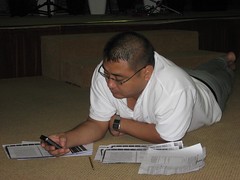
Bet you never knew READING a script could get so creative...and complicated!
KEY POINT: Direct for picky details, like opening and closing your scripts together, actors starting their lines with their noses out of their notebooks, being CLEAR about where actors look when using offstage focus (if it's fuzzy to them, it will never work to create the illusion for your audience.



Monday, October 23, 2006
Tuesday, October 10, 2006
Our final weeks
THE PLANS
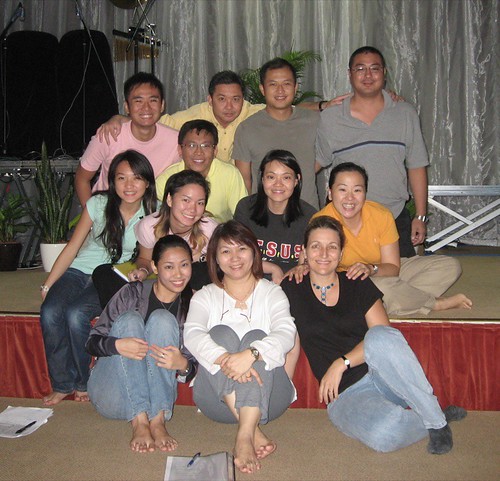
WEEK 7 (10/10):
Glossary Quiz & discussion of terms
Review memorized section of Acts
Traveling Light: Pig Farmer monologue by Christine Yong
Acting: Improvisation handout p22
Game: Freeze (warmed up by thinking up
Conflict situations)
Homework: Memorize your section of Acts 1 & 2
Better get started reading at least 100pgs of a theatre book from the list.
You can prepare for improvs next week by reading text pages 61-83
WEEK 8 (17/10):
More Improvs
Acting Class: exercises on creating a character p23
Character Analysis (short & long) p24-29
Rehearse Acts for International Night
Diamond Ensemble for International Night
Homework for next week: Playback Theatre reading
23 October, International Night. Details
WEEK 9 (24/10):
300 word reaction paper due
Playback Theatre demonstration
Trying out Enacted Prayer – with Tapestry Playback
Homework for next week draft ideas for your student presentation
WEEK 10 (31/10):
Reader’s Theatre
“The Case of the Unemployed Sunday School Leader”
More on Creating Characters (if it doesn’t get done 17/10)
Discuss options for projects (discuss your homework)
Homework for next week: read dance notes
WEEK 11 (7/11):
More improvisation
Dance Overview with Jaqueline & Elaine! Loads of video and demos.
Quiz 3: Playback, Reader’s Theatre, Acting (whew!)
Homework: Prepare presentations!
WEEKS 12 & 13 (14 & 21/11)
Quiz 4: Dance, Staging & Directing
Depending on what students pick, part of week 12 can be time for rehearsal.
Student Presentations/Performances
THE PLANS

WEEK 7 (10/10):
Glossary Quiz & discussion of terms
Review memorized section of Acts
Traveling Light: Pig Farmer monologue by Christine Yong
Acting: Improvisation handout p22
Game: Freeze (warmed up by thinking up
Conflict situations)
Homework: Memorize your section of Acts 1 & 2
Better get started reading at least 100pgs of a theatre book from the list.
You can prepare for improvs next week by reading text pages 61-83
WEEK 8 (17/10):
More Improvs
Acting Class: exercises on creating a character p23
Character Analysis (short & long) p24-29
Rehearse Acts for International Night
Diamond Ensemble for International Night
Homework for next week: Playback Theatre reading
23 October, International Night. Details
WEEK 9 (24/10):
300 word reaction paper due
Playback Theatre demonstration
Trying out Enacted Prayer – with Tapestry Playback
Homework for next week draft ideas for your student presentation
WEEK 10 (31/10):
Reader’s Theatre
“The Case of the Unemployed Sunday School Leader”
More on Creating Characters (if it doesn’t get done 17/10)
Discuss options for projects (discuss your homework)
Homework for next week: read dance notes
WEEK 11 (7/11):
More improvisation
Dance Overview with Jaqueline & Elaine! Loads of video and demos.
Quiz 3: Playback, Reader’s Theatre, Acting (whew!)
Homework: Prepare presentations!
WEEKS 12 & 13 (14 & 21/11)
Quiz 4: Dance, Staging & Directing
Depending on what students pick, part of week 12 can be time for rehearsal.
Student Presentations/Performances
Wednesday, October 04, 2006
Gilbert top ranked sketch was a "9"
(find more reviews under the comments of the very first post in this blog SKETCH EVALUATIONS)
Name of Sketch: To Have and to Hold ?
Name of Sketch Collection/Book: The Comfort Zone : 11 Sketches to Challenge and Encourage Christian Faith
Publisher: Lillenas Publishing Company
Copywrite date: 2000
MESSAGE: The significance of the marriage vow. It is about accountability between husband and wife, commitment to family as well as the need for open communications. It is relevant as in this era of high divorce rate, the Church should do all it can to preserve marriages. Nothing was mentioned about God throughout the sketch.
THEME : The theme is about a husband and wife who's live priorities have departed and the lost of faith in each other ultimately resulted in the D word being mentioned.
STRUCTURE:
The inciting action occurs when Larry and Ellen argues about Ellen having bought new clothings for their child as Larry would like to get a new set of tyres for his car instead. It leads on to the rising action where Ellen probes and found out that her husband has been working with Sheila Bergman without accounting to her. The context was that they had fought over her before. The climax came when Larry broke the news that he wanted a divorce as he felt that things are just not working out between Ellen and him. This was followed by the denoument where Ellen tries to take in the news and concludes with Larry walking out of the house. It is quite predictable as how could Larry and Ellen be husband and wife when their priorities are so far apart. Through the sketch, it was slowly revealed that they could have grown apart over the years due to lack of communication and erosion of faith in each other with the appearance of Sheila Bergman. This sow the seed for reflection.
STYLE: The style used is a sketch.
TARGET AUDIENCE: The target audience include adults and youth; both Christians as well as the Unchurched, single or married.
PERFORMERS NEED TO BE: The dialogue is simple and the performers could be Beginners or Intermediate.
PRODUCTION: The notes are adequate and it is easy to produce. No elaborate props are required.
On a scale of 1-10, how would you rate this script?
9
Do you feel that it would work in your setting without modifications?
Yes as it is highly identifiable and generates quite a lot of reflection.
(find more reviews under the comments of the very first post in this blog SKETCH EVALUATIONS)
Name of Sketch: To Have and to Hold ?
Name of Sketch Collection/Book: The Comfort Zone : 11 Sketches to Challenge and Encourage Christian Faith
Publisher: Lillenas Publishing Company
Copywrite date: 2000
MESSAGE: The significance of the marriage vow. It is about accountability between husband and wife, commitment to family as well as the need for open communications. It is relevant as in this era of high divorce rate, the Church should do all it can to preserve marriages. Nothing was mentioned about God throughout the sketch.
THEME : The theme is about a husband and wife who's live priorities have departed and the lost of faith in each other ultimately resulted in the D word being mentioned.
STRUCTURE:
The inciting action occurs when Larry and Ellen argues about Ellen having bought new clothings for their child as Larry would like to get a new set of tyres for his car instead. It leads on to the rising action where Ellen probes and found out that her husband has been working with Sheila Bergman without accounting to her. The context was that they had fought over her before. The climax came when Larry broke the news that he wanted a divorce as he felt that things are just not working out between Ellen and him. This was followed by the denoument where Ellen tries to take in the news and concludes with Larry walking out of the house. It is quite predictable as how could Larry and Ellen be husband and wife when their priorities are so far apart. Through the sketch, it was slowly revealed that they could have grown apart over the years due to lack of communication and erosion of faith in each other with the appearance of Sheila Bergman. This sow the seed for reflection.
STYLE: The style used is a sketch.
TARGET AUDIENCE: The target audience include adults and youth; both Christians as well as the Unchurched, single or married.
PERFORMERS NEED TO BE: The dialogue is simple and the performers could be Beginners or Intermediate.
PRODUCTION: The notes are adequate and it is easy to produce. No elaborate props are required.
On a scale of 1-10, how would you rate this script?
9
Do you feel that it would work in your setting without modifications?
Yes as it is highly identifiable and generates quite a lot of reflection.
Rachel Eric found a 10!
Name of Sketch: The Dream by Lisa Harper
Name of Sketch Collection/Book: Drama Team Handbook by Alison Siewert & Others
Publisher: InterVarsity Press
Copywrite Date: 2003
Style: Reader’s Theatre? (This I have to check out)
Target Audience: African American Youth/Young Adults, Christians or Non-Christians
Performers need to be: Intermediate – Advanced
On a scale of 1-10, I would honestly give this sketch a 10! Well, my rating may not be completely objective. Being completely green in this craft, perhaps certain things that make a script a good or bad one may escape me. But as I evaluate it with what we’ve learnt and from a standpoint of an audience, it’s totally got me hooked and made quite an impression in me.
Structure:
The sketch is about a couple, Jerry and Tina talking about their last date to a movie titled ‘Real Women Have Curves’ (exposition) where the Jerry falls asleep because the lead actress “…ain’t curvy. She’s fat!” (inciting incident). This leads to each character airing out (quite unconsciously) their internal struggles. For Jerry, it’s a struggle with lust and for Tina it’s trying to conform to a stereotypical image in order to be loved (rising action). The climax comes about quite suprisingly when Jerry, as he’s speaking, realizes he may very well be turning into a “playa” just like his father was and turns to say “God, help.” And Tina realizing she is worth more than looking perfection just to be loved and (reveals) she has let it go by shaving her head bald (!!!). The couple interact with each other on stage for the first time with Jerry seeing Tina head shaved and all, and saying with conviction “I love you”(denouement).
Yes, I was completely hooked from the very beginning; mainly due to these elements:
1) The outline of the sketch can be easily identified. The exposition, inciting incident, rising action, climax and denouement are clear-cut. This makes it so simple to follow the plot. Especially when it is staged so uniquely, with two characters speaking separate yet interwoven lines, showing separate perspectives on the very same situation/issue.
2) The dialogue though a recollection of the events/ narration of thoughts and feelings, were written with lines that are sharp to the point. The flavor of the African American culture is evident in these lines too, making it all so authentic. I especially loved how the interwoven lines beautifully (and at places humorously) compliment each other, making the entire sketch flow clearly in one direction.
3) Real. The entire sketch is very real. The characters are written so real. Real as African Americans. Real as human beings. As I was reading the sketch, I was so caught up in it because it was so believable. The young generation of African Americans and other ethnic groups, I believe, would really be able to identify with the premise, conflict and characters.
-The premise: The sketch is about a couple each ‘telling it as it is’ from their own points of view. They are doing so casually facing the audience. It seems like the audience is a friend to the couple, hearing each “side of the story”. A familiar scene? I believe most people has been in such a situation, hearing at least one person talk about their side of the story and what they think of their spouse/boyfriend’s actions etc.
-Conflict: While at the beginning the conflict seems to center on Tina’s dislike of Jerry’s habit of looking at other girls, later it sinks deeper into their internal struggles. Jerry’s inner conflict centers around becoming a beautiful person on the inside as he discovers that what he likes in a girl may very well be lust, and how this could very well be turning him into a “playa”. Tina is conflicted with the issue of conformity. Conformity to a certain image or look in order to feel beautiful and be loved. Once again a very real conflict in the day and age we live in where the images portrayed by media seems to indoctrinate a certain perfect yet near impossible stereotype or standard to reach in order to be loved, successful or happy.
-Characters: I finished reading the sketch feeling that these two characters could be my friends. Their strengths, weaknesses, struggles, quirks were so well voiced, you can’t help but feel drawn to them.
4) Surprise: The sketch really caught me with my mouth gaping open in the end. Never would I have imagined the character of Tina making a stand by having her head shaved. But then again, this made the conclusion all the more satisfactory. For me, this action conveys what words never will be able too…freedom from conformity, shedding of insecurity, truly knowing that beauty is within, loving and accepting oneself, purification and other expressions I am unable to describe.
Message:
The theme of this sketch, as I see it, revolves around the question “What is beauty…without substance?” It deals with these interconnected issues of conformity to what’s been stereotyped in society and accepting/loving oneself. Very relevant issues in this age of society.
It provides a Biblical perspective on these issues in a contemporary way. As I was reading the sketch, I could pick up principals on inner beauty as highlighted in:
-Proverbs 31 which explores a woman of noble character who “is worth more than precious rubies”
-1 Peter 3:1-8 nicely sums up for a woman that she “… should be known for the beauty that comes from within…” and for a man that he should “…give honor…”
-1 Corinthians 10:13 beautifully encourages that temptations can be overcome
because of God’s grace.
-Genesis 1:27 that assures us that there is only one perfect image and we are made “in His own image”. What’s so great about this sketch is that for it’s length it truly does “Show, Don’t tell” the above scriptural principals without being preachy or overbearing any elements. Perhaps a new or non-Christian may be unable to detect the Scriptural basis that forms the sketch. I guess this is where a pastor could do a good job of addressing the issues of the sketch through a message on the above or other scriptures.
Whether the end of the sketch (denouement) was cliched, I’m sure can be debatable. One part of me argues it’s shows too simple a solution to a real challenging issue: calling on God and shaving your head bald. The other part of me argues however, that these actions are exactly what they are. Actions- for the audience to realize that a solution is available. But they must act on the problem. And to a Christian, a first course of action is prayer of confession and help.
Production:
The production notes are limited to gestures/actions, lights out and how lines are spoken (interwoven). Perhaps because this sketch was written like a reader’s theatre-simple and direct. Thus the director and actors, especially the inexperienced, will have to consider other unspoken production details such as how the words should be spoken, do the characters move about, and if they do in which stage directions etc. This sketch is so simply written it’s definitely possible to produce. Perhaps with a bit of modifications though, to fit in with the culture here. From observation, I feel these issues relate well to the Malay and Indian communities in Singapore. With the dialogue interchanged with the flavors of their unique expressions and certain things mentioned such as hairstyles and name of the make-up cream, names of models or rap stars changed to suit the local context, it would definitely make an impact.
Quote is a section heading from Pederson, Steve, Drama Ministry: Practical Help for Making Drama a Vital Part of Your Church, Chapter 6, Pg119, Grand Rapids, MI: Zondervan, 1999.
* All Scriptures references taken from the New Living Translation, Metal Edition
Name of Sketch: The Dream by Lisa Harper
Name of Sketch Collection/Book: Drama Team Handbook by Alison Siewert & Others
Publisher: InterVarsity Press
Copywrite Date: 2003
Style: Reader’s Theatre? (This I have to check out)
Target Audience: African American Youth/Young Adults, Christians or Non-Christians
Performers need to be: Intermediate – Advanced
On a scale of 1-10, I would honestly give this sketch a 10! Well, my rating may not be completely objective. Being completely green in this craft, perhaps certain things that make a script a good or bad one may escape me. But as I evaluate it with what we’ve learnt and from a standpoint of an audience, it’s totally got me hooked and made quite an impression in me.
Structure:
The sketch is about a couple, Jerry and Tina talking about their last date to a movie titled ‘Real Women Have Curves’ (exposition) where the Jerry falls asleep because the lead actress “…ain’t curvy. She’s fat!” (inciting incident). This leads to each character airing out (quite unconsciously) their internal struggles. For Jerry, it’s a struggle with lust and for Tina it’s trying to conform to a stereotypical image in order to be loved (rising action). The climax comes about quite suprisingly when Jerry, as he’s speaking, realizes he may very well be turning into a “playa” just like his father was and turns to say “God, help.” And Tina realizing she is worth more than looking perfection just to be loved and (reveals) she has let it go by shaving her head bald (!!!). The couple interact with each other on stage for the first time with Jerry seeing Tina head shaved and all, and saying with conviction “I love you”(denouement).
Yes, I was completely hooked from the very beginning; mainly due to these elements:
1) The outline of the sketch can be easily identified. The exposition, inciting incident, rising action, climax and denouement are clear-cut. This makes it so simple to follow the plot. Especially when it is staged so uniquely, with two characters speaking separate yet interwoven lines, showing separate perspectives on the very same situation/issue.
2) The dialogue though a recollection of the events/ narration of thoughts and feelings, were written with lines that are sharp to the point. The flavor of the African American culture is evident in these lines too, making it all so authentic. I especially loved how the interwoven lines beautifully (and at places humorously) compliment each other, making the entire sketch flow clearly in one direction.
3) Real. The entire sketch is very real. The characters are written so real. Real as African Americans. Real as human beings. As I was reading the sketch, I was so caught up in it because it was so believable. The young generation of African Americans and other ethnic groups, I believe, would really be able to identify with the premise, conflict and characters.
-The premise: The sketch is about a couple each ‘telling it as it is’ from their own points of view. They are doing so casually facing the audience. It seems like the audience is a friend to the couple, hearing each “side of the story”. A familiar scene? I believe most people has been in such a situation, hearing at least one person talk about their side of the story and what they think of their spouse/boyfriend’s actions etc.
-Conflict: While at the beginning the conflict seems to center on Tina’s dislike of Jerry’s habit of looking at other girls, later it sinks deeper into their internal struggles. Jerry’s inner conflict centers around becoming a beautiful person on the inside as he discovers that what he likes in a girl may very well be lust, and how this could very well be turning him into a “playa”. Tina is conflicted with the issue of conformity. Conformity to a certain image or look in order to feel beautiful and be loved. Once again a very real conflict in the day and age we live in where the images portrayed by media seems to indoctrinate a certain perfect yet near impossible stereotype or standard to reach in order to be loved, successful or happy.
-Characters: I finished reading the sketch feeling that these two characters could be my friends. Their strengths, weaknesses, struggles, quirks were so well voiced, you can’t help but feel drawn to them.
4) Surprise: The sketch really caught me with my mouth gaping open in the end. Never would I have imagined the character of Tina making a stand by having her head shaved. But then again, this made the conclusion all the more satisfactory. For me, this action conveys what words never will be able too…freedom from conformity, shedding of insecurity, truly knowing that beauty is within, loving and accepting oneself, purification and other expressions I am unable to describe.
Message:
The theme of this sketch, as I see it, revolves around the question “What is beauty…without substance?” It deals with these interconnected issues of conformity to what’s been stereotyped in society and accepting/loving oneself. Very relevant issues in this age of society.
It provides a Biblical perspective on these issues in a contemporary way. As I was reading the sketch, I could pick up principals on inner beauty as highlighted in:
-Proverbs 31 which explores a woman of noble character who “is worth more than precious rubies”
-1 Peter 3:1-8 nicely sums up for a woman that she “… should be known for the beauty that comes from within…” and for a man that he should “…give honor…”
-1 Corinthians 10:13 beautifully encourages that temptations can be overcome
because of God’s grace.
-Genesis 1:27 that assures us that there is only one perfect image and we are made “in His own image”. What’s so great about this sketch is that for it’s length it truly does “Show, Don’t tell” the above scriptural principals without being preachy or overbearing any elements. Perhaps a new or non-Christian may be unable to detect the Scriptural basis that forms the sketch. I guess this is where a pastor could do a good job of addressing the issues of the sketch through a message on the above or other scriptures.
Whether the end of the sketch (denouement) was cliched, I’m sure can be debatable. One part of me argues it’s shows too simple a solution to a real challenging issue: calling on God and shaving your head bald. The other part of me argues however, that these actions are exactly what they are. Actions- for the audience to realize that a solution is available. But they must act on the problem. And to a Christian, a first course of action is prayer of confession and help.
Production:
The production notes are limited to gestures/actions, lights out and how lines are spoken (interwoven). Perhaps because this sketch was written like a reader’s theatre-simple and direct. Thus the director and actors, especially the inexperienced, will have to consider other unspoken production details such as how the words should be spoken, do the characters move about, and if they do in which stage directions etc. This sketch is so simply written it’s definitely possible to produce. Perhaps with a bit of modifications though, to fit in with the culture here. From observation, I feel these issues relate well to the Malay and Indian communities in Singapore. With the dialogue interchanged with the flavors of their unique expressions and certain things mentioned such as hairstyles and name of the make-up cream, names of models or rap stars changed to suit the local context, it would definitely make an impact.
Quote is a section heading from Pederson, Steve, Drama Ministry: Practical Help for Making Drama a Vital Part of Your Church, Chapter 6, Pg119, Grand Rapids, MI: Zondervan, 1999.
* All Scriptures references taken from the New Living Translation, Metal Edition
Monday, October 02, 2006
From Puay Hong
Sketches from the Book
Sunday Morning Live Vol 1
Name of Sketch: Tired When Needed
Name of Sketch Collection/Book:
Publisher: Zondervan Publishing House
Copywrite date: 1992
On a scale of 1-10, how would you rate this script? 9
Do you feel that it would work in your setting without modifications?
Not entirely because the actor loves hunting as a hobby and there is no such hunting hobby in Singapore. Maybe can replace the hunting with golf or something else.
Do you feel it would work with minor modifications
(To honor copyright, it is best to check through the publisher about modifications)? Yes.
STYLE: Comedy
TARGET AUDIENCE: Christians
PERFORMERS NEED TO BE: Intermediate
STRUCTURE:
Yes, it grabs my interest and makes me want to see what happens because I am wondering how the main character is going to say “No” to this overbearing lady. Yes, it develops logically with inciting action, rising action and climax. In fact, it even has some humour within the dialogue.
What is the playwright’s theme? (issue) The theme is about christians who are over stretched in their involvement in too many activities. It is also the expectation of the others that
Is the premise believable? (what happens) Yes.
Does it have clear and adequate conflict? What is the conflict? Yes, the conflict is that one expects the main character to help out because he has always been helpful but he is too tired and burnt out to be involved anymore.
Does it appeal to the imagination? Yes.
If a comedy sketch, is it funny? Yes, it is funny.
MESSAGE:
The message is that one should learn to say “No” before one gets burnt out. Also we should not expect people who have been helpful to keep on helping and doing. We should get others to help out instead of the same people. Yes, the message is very relevant and it only deals with one issue.
PRODUCTION:
Yes, it is possible to produce it.
Name of Sketch: Prayer Group Therapy
Name of Sketch Collection/Book: Sunday Morning Live Vol 5
Publisher: Zondervan Publishing House
Copywrite date: 1993
On a scale of 1-10, how would you rate this script? 9
Do you feel that it would work in your setting without modifications? Yes.
STYLE: Comedy
TARGET AUDIENCE:Christians
PERFORMERS NEED TO BE: Intermediate
STRUCTURE:
Yes, it grabs my interest to know how the “prayer” will end. The story develops logically even though I feel that some of the character might not have enough to develop. The conclusion is quite satisfying as I think that it is not easy to end the “prayer”. Of course, I would have preferred it not to end this way ( but I do not know how it should end otherwise too).
What is the playwright’s theme? (issue) About how different people view prayers.
Is the premise believable? (what happens) Yes.
Does it have clear and adequate conflict? What is the conflict?
Yes, it has clear conflict between the different “pray-ers”.
Does it appeal to the imagination? Yes.
If a comedy sketch, is it funny? Yes.
MESSAGE:
I think it is very relevant as there are many different types of people – some who use prayer as gossip, some who use “big words” etc. It makes people think of the way they pray and their motives for praying.
PRODUCTION:
Yes, it is possible to produce.
Sketches from the Book
Sunday Morning Live Vol 1
Name of Sketch: Tired When Needed
Name of Sketch Collection/Book:
Publisher: Zondervan Publishing House
Copywrite date: 1992
On a scale of 1-10, how would you rate this script? 9
Do you feel that it would work in your setting without modifications?
Not entirely because the actor loves hunting as a hobby and there is no such hunting hobby in Singapore. Maybe can replace the hunting with golf or something else.
Do you feel it would work with minor modifications
(To honor copyright, it is best to check through the publisher about modifications)? Yes.
STYLE: Comedy
TARGET AUDIENCE: Christians
PERFORMERS NEED TO BE: Intermediate
STRUCTURE:
Yes, it grabs my interest and makes me want to see what happens because I am wondering how the main character is going to say “No” to this overbearing lady. Yes, it develops logically with inciting action, rising action and climax. In fact, it even has some humour within the dialogue.
What is the playwright’s theme? (issue) The theme is about christians who are over stretched in their involvement in too many activities. It is also the expectation of the others that
Is the premise believable? (what happens) Yes.
Does it have clear and adequate conflict? What is the conflict? Yes, the conflict is that one expects the main character to help out because he has always been helpful but he is too tired and burnt out to be involved anymore.
Does it appeal to the imagination? Yes.
If a comedy sketch, is it funny? Yes, it is funny.
MESSAGE:
The message is that one should learn to say “No” before one gets burnt out. Also we should not expect people who have been helpful to keep on helping and doing. We should get others to help out instead of the same people. Yes, the message is very relevant and it only deals with one issue.
PRODUCTION:
Yes, it is possible to produce it.
Name of Sketch: Prayer Group Therapy
Name of Sketch Collection/Book: Sunday Morning Live Vol 5
Publisher: Zondervan Publishing House
Copywrite date: 1993
On a scale of 1-10, how would you rate this script? 9
Do you feel that it would work in your setting without modifications? Yes.
STYLE: Comedy
TARGET AUDIENCE:Christians
PERFORMERS NEED TO BE: Intermediate
STRUCTURE:
Yes, it grabs my interest to know how the “prayer” will end. The story develops logically even though I feel that some of the character might not have enough to develop. The conclusion is quite satisfying as I think that it is not easy to end the “prayer”. Of course, I would have preferred it not to end this way ( but I do not know how it should end otherwise too).
What is the playwright’s theme? (issue) About how different people view prayers.
Is the premise believable? (what happens) Yes.
Does it have clear and adequate conflict? What is the conflict?
Yes, it has clear conflict between the different “pray-ers”.
Does it appeal to the imagination? Yes.
If a comedy sketch, is it funny? Yes.
MESSAGE:
I think it is very relevant as there are many different types of people – some who use prayer as gossip, some who use “big words” etc. It makes people think of the way they pray and their motives for praying.
PRODUCTION:
Yes, it is possible to produce.
Name of sketch: First Bank of Do Unto Others
Name of sketch collection/book: The Comfort Zone: 11 Sketches
Publisher: Lillenas, Nazarene Publishing House
Author: Chuck Neighbors
On a scale of 1-10, I rate this sketch 8
No modification is needed. Easy to understand everywhere and any where.
STYLE: Comedy
TARGET AUDIENCE: Churched, Adult, Youth
STRUCTURE: EXPOSITION, looks like a normal bank teller and customer, however, only when Mitch wanted to withdraw “smiles” and “encouragements” that we know that, it’s a not so unrealistic sketch. First conflict was introduced when Mitch had overdrawn his account and he didn’t believe it (INCITING ACTION). However, only a couple of conflicts were used in this sketch (RISING ACTION), thus, rising action isn’t that significant. CLIMAX reached when Mitch wanted to withdraw from his wife’s account but realized that the accounts aren’t transferable. DENOUMENT, Mitch realized the whole policy of the bank and how it works.
Emphasized on Christian value of “Do unto others what you will have them do unto you.” , however, not preachy at all. Concept is easy to understand.
Conflicts are not strong however.
Easy to produce =)
Name of sketch collection/book: The Comfort Zone: 11 Sketches
Publisher: Lillenas, Nazarene Publishing House
Author: Chuck Neighbors
On a scale of 1-10, I rate this sketch 8
No modification is needed. Easy to understand everywhere and any where.
STYLE: Comedy
TARGET AUDIENCE: Churched, Adult, Youth
STRUCTURE: EXPOSITION, looks like a normal bank teller and customer, however, only when Mitch wanted to withdraw “smiles” and “encouragements” that we know that, it’s a not so unrealistic sketch. First conflict was introduced when Mitch had overdrawn his account and he didn’t believe it (INCITING ACTION). However, only a couple of conflicts were used in this sketch (RISING ACTION), thus, rising action isn’t that significant. CLIMAX reached when Mitch wanted to withdraw from his wife’s account but realized that the accounts aren’t transferable. DENOUMENT, Mitch realized the whole policy of the bank and how it works.
Emphasized on Christian value of “Do unto others what you will have them do unto you.” , however, not preachy at all. Concept is easy to understand.
Conflicts are not strong however.
Easy to produce =)
from Amy Lin
Name of sketch: Gossip, They Wrote
(same scketch collection as below)
On a scale of 1-10, I rate this sketch 7
This sketch does not need much modification, however, this sketch is little bit cartoonish, with the characters and setting. I do not think that a church would have a gossip magazine like the one mentioned in the script.
STYLE: Comedy
TARGET AUDIENCE: Churched, Adult, Youth
STRUCTURE: We only knew that this newspaper office is for the church magazine when the Choir Director was mentioned (EXPOSITION). First conflict was introduced when Ken mentioned about breaking the Ten Commandments (INCITING ACTION). RISING ACTION continues till Ken has something “gossipy” about Jackie. Ken turned the table back to Jackie. Jackie was not too happy about it and disagree with the idea of writing those topic (CLIMAX). Ken made Jackie realized that gossip isn’t that fun when you are the subject (DENOUMENT).
The theme of this sketch is talking about how gossips are not good for the spirit, especially if you are the subject of the topic. Gossips are things that will mislead others.
Conflicts are clear and sufficient.
It does emphasize on the Christian values of how Christians should not gossip. But this sketch is also applicable to unchurched audience (though not for salvation), but for
Easy to produce =)
Name of sketch: Gossip, They Wrote
(same scketch collection as below)
On a scale of 1-10, I rate this sketch 7
This sketch does not need much modification, however, this sketch is little bit cartoonish, with the characters and setting. I do not think that a church would have a gossip magazine like the one mentioned in the script.
STYLE: Comedy
TARGET AUDIENCE: Churched, Adult, Youth
STRUCTURE: We only knew that this newspaper office is for the church magazine when the Choir Director was mentioned (EXPOSITION). First conflict was introduced when Ken mentioned about breaking the Ten Commandments (INCITING ACTION). RISING ACTION continues till Ken has something “gossipy” about Jackie. Ken turned the table back to Jackie. Jackie was not too happy about it and disagree with the idea of writing those topic (CLIMAX). Ken made Jackie realized that gossip isn’t that fun when you are the subject (DENOUMENT).
The theme of this sketch is talking about how gossips are not good for the spirit, especially if you are the subject of the topic. Gossips are things that will mislead others.
Conflicts are clear and sufficient.
It does emphasize on the Christian values of how Christians should not gossip. But this sketch is also applicable to unchurched audience (though not for salvation), but for
Easy to produce =)
from Amy Lin
Name of sketch: Why wait?
Name of sketch collection/book: The Comfort Zone: 11 sketches to challenge
Publisher: Chuck Neighbors
Copywrite Date:
On the scale of 1-10, I rate this sketch 9
No modification is needed in this sketch, can be used anywhere and any place.
STYLE: Realistic Drama, Comedy
TARGET AUDIENCE: Youth, Parents, Church, Unchurch
STRUCTURE: It grabs my interest as this topic is seldom touched in church (my church at least). We know from the beginning of the sketch that Jason is talking to his dad about him and his girlfriend, although this EXPOSITION is pretty straight forward. The first conflict was introduced when Jason told his dad that he is serious in his relationship with Amy, however, his dad thinks that they are still young and are still in high school (INCITING ACTION). Further conflicts were introduced in the sketch as Jason tried to ask whether his dad and mom “waited” till marriage. On the other hand, hid dad was not keen on answering that question (he’s GUILTY!!). This dragged on for a little while, like a tug of war (RISING ACTION). CLIMAX was reached when his dad finally answered Jason’s question, which they did not waited till marriage. However, his dad explained to Jason why it is good for him to wait, he sounded regretful. His dad also made Jason promise that he would wait (DENOUMENT).
The theme of this sketch is sexual responsibility/morality, parenting, dating
I like this sketch as it is very true to what’s happening in young people today and it is also very true to parents. They don’t feel comfortable when talking to their kids about sexual issues, especially when they themselves did not “wait till marriage” (no example set). This sketch is definitely believable, it gives me a feeling that “that’s so true”.
Conflicts are clear and there are adequate conflicts throughout the whole sketch, again, very true!!
A lot of Christian value in this sketch but no God was mentioned. Neither the bible was mentioned. Definitely not preachy!
Definitely easy to produce as well
I like this sketch! =P
Name of sketch: Why wait?
Name of sketch collection/book: The Comfort Zone: 11 sketches to challenge
Publisher: Chuck Neighbors
Copywrite Date:
On the scale of 1-10, I rate this sketch 9
No modification is needed in this sketch, can be used anywhere and any place.
STYLE: Realistic Drama, Comedy
TARGET AUDIENCE: Youth, Parents, Church, Unchurch
STRUCTURE: It grabs my interest as this topic is seldom touched in church (my church at least). We know from the beginning of the sketch that Jason is talking to his dad about him and his girlfriend, although this EXPOSITION is pretty straight forward. The first conflict was introduced when Jason told his dad that he is serious in his relationship with Amy, however, his dad thinks that they are still young and are still in high school (INCITING ACTION). Further conflicts were introduced in the sketch as Jason tried to ask whether his dad and mom “waited” till marriage. On the other hand, hid dad was not keen on answering that question (he’s GUILTY!!). This dragged on for a little while, like a tug of war (RISING ACTION). CLIMAX was reached when his dad finally answered Jason’s question, which they did not waited till marriage. However, his dad explained to Jason why it is good for him to wait, he sounded regretful. His dad also made Jason promise that he would wait (DENOUMENT).
The theme of this sketch is sexual responsibility/morality, parenting, dating
I like this sketch as it is very true to what’s happening in young people today and it is also very true to parents. They don’t feel comfortable when talking to their kids about sexual issues, especially when they themselves did not “wait till marriage” (no example set). This sketch is definitely believable, it gives me a feeling that “that’s so true”.
Conflicts are clear and there are adequate conflicts throughout the whole sketch, again, very true!!
A lot of Christian value in this sketch but no God was mentioned. Neither the bible was mentioned. Definitely not preachy!
Definitely easy to produce as well
I like this sketch! =P
from Amy Lin
Name of sketch: The Comfort Zone
Name of sketch collection/book: The Comfort Zone: 11 sketches to challenge
Publisher: Chuck Neighbors
Copywrite Date:
On a scale of 1-10, I rate this script 7
The sketch may need alittle modification depending of where it will be performed. Some churches might not be able to take the dialogues of this sketch.
STYLE: Comedy
TARGET AUDIENCE: Churched, Youth
STRUCTURE: It grabs my interest and makes me want to know what happens next. Right from the beginning the script told me that this setting developed in a family (EXPOSITION). The first conflict was introduced when the mum could not agree with what her daughter was wearing for church (INCITING ACTION). Other conflicts were introduced when mom and dad were discussing about the way another church was functioning (RISING ACTION), however, I do not think that there is a very clear rising action here. Due to the lack of rising action, I could not really identify the climax of the sketch. However, if I were to identify the climax, it would be when the mom said that it was inappropriate that there is drama in the church. The rest of the script brings about the DENOUMENT and ended off when the family sets of to church. However, I like the ending of sketch when the mom was humming the same tune as her daughter (some contemporary music) and then change to “Amazing grace”. It made the whole sketch so funny as the mom was complaining about what should not be done in church, but she is doing it outside church.
The theme of this sketch is about people’s perception of church in transition or contemporary church
It is not predictable as I kept on reading, wanting to know what happens next. The dialogues of the sketch are very realistic and as I read on, I agree together with the writer that this may be the things that some people may say.
The sketch is not preachy as it did not bring up any Christian values but just what some Christians perception about other churches
It is an easy sketch to produce; however, it might not apply to every church. The church has to be open minded to accept such a sketch.
Name of sketch: The Comfort Zone
Name of sketch collection/book: The Comfort Zone: 11 sketches to challenge
Publisher: Chuck Neighbors
Copywrite Date:
On a scale of 1-10, I rate this script 7
The sketch may need alittle modification depending of where it will be performed. Some churches might not be able to take the dialogues of this sketch.
STYLE: Comedy
TARGET AUDIENCE: Churched, Youth
STRUCTURE: It grabs my interest and makes me want to know what happens next. Right from the beginning the script told me that this setting developed in a family (EXPOSITION). The first conflict was introduced when the mum could not agree with what her daughter was wearing for church (INCITING ACTION). Other conflicts were introduced when mom and dad were discussing about the way another church was functioning (RISING ACTION), however, I do not think that there is a very clear rising action here. Due to the lack of rising action, I could not really identify the climax of the sketch. However, if I were to identify the climax, it would be when the mom said that it was inappropriate that there is drama in the church. The rest of the script brings about the DENOUMENT and ended off when the family sets of to church. However, I like the ending of sketch when the mom was humming the same tune as her daughter (some contemporary music) and then change to “Amazing grace”. It made the whole sketch so funny as the mom was complaining about what should not be done in church, but she is doing it outside church.
The theme of this sketch is about people’s perception of church in transition or contemporary church
It is not predictable as I kept on reading, wanting to know what happens next. The dialogues of the sketch are very realistic and as I read on, I agree together with the writer that this may be the things that some people may say.
The sketch is not preachy as it did not bring up any Christian values but just what some Christians perception about other churches
It is an easy sketch to produce; however, it might not apply to every church. The church has to be open minded to accept such a sketch.
From Amy Lin
Sketch evaluation
To have and to hold
Name of sketch collection/Book: Power plays Vol. 4
Publisher: Baker Book House
Copywrite Date:
On a scale of 1-10, I rate this script 7
Other than the place (Seattle) needs to be place to suit which ever place that this sketch is going to take place, the setting will work in any place without modifications. This script is very down-to-earth, in everyday life of a couple. Every married couple would have experienced this somehow down their marriage road.
STYLE: Realistic Drama
TARGET AUDIENCE: Married couples, church/unchurch
STRUCTURE: It definitely grabs my interest without me predicting what’s coming on next (maybe because I’m not married, HA!). It makes me want to read on further to find out what the wife was going to say to the husband. The start of the script told me that the man and woman are married with kids, when the topic of the kids came out in the script (EXPOSITION). It went on with the husband and wife in the kitchen talking about everyday issue (finance). The first conflict was introduced (INCITING ACTION) when the husband wanted to use the $150 to buy tires while the wife spent it on the kids. The husband could not understand why the kids need to buy new clothes anyway. The script developed with other conflicts introduced (RISING ACTION). The husband couldn’t care less about any other things, other than himself. It continued to rise to the topic of the husband’s business partner was brought up, and his previous affair. This CLIMAX reached when the husband brought up the issue of a divorce. The husband then told the wife as-a-matter-of-factly that he doesn’t love her anymore (DENOUMENT).
The theme of this script is everyday conflict between married couples.
The premise is very believable as more often than not, married couples experience this kind of issue in their marriage life.
Conflicts in this script were clearly introduced and there were sufficient conflicts in the 5 minutes sketch.
I guess, this sketch is so real to everyday life of a couple that, although to the script writer, it might be predictable, this sketch may still be able to grab the interest of the audience due to the realistic of it.
It is not preachy at all due to the setting of the sketch and definitely relevant.
It is definitely an easy sketch to produce.
Sketch evaluation
To have and to hold
Name of sketch collection/Book: Power plays Vol. 4
Publisher: Baker Book House
Copywrite Date:
On a scale of 1-10, I rate this script 7
Other than the place (Seattle) needs to be place to suit which ever place that this sketch is going to take place, the setting will work in any place without modifications. This script is very down-to-earth, in everyday life of a couple. Every married couple would have experienced this somehow down their marriage road.
STYLE: Realistic Drama
TARGET AUDIENCE: Married couples, church/unchurch
STRUCTURE: It definitely grabs my interest without me predicting what’s coming on next (maybe because I’m not married, HA!). It makes me want to read on further to find out what the wife was going to say to the husband. The start of the script told me that the man and woman are married with kids, when the topic of the kids came out in the script (EXPOSITION). It went on with the husband and wife in the kitchen talking about everyday issue (finance). The first conflict was introduced (INCITING ACTION) when the husband wanted to use the $150 to buy tires while the wife spent it on the kids. The husband could not understand why the kids need to buy new clothes anyway. The script developed with other conflicts introduced (RISING ACTION). The husband couldn’t care less about any other things, other than himself. It continued to rise to the topic of the husband’s business partner was brought up, and his previous affair. This CLIMAX reached when the husband brought up the issue of a divorce. The husband then told the wife as-a-matter-of-factly that he doesn’t love her anymore (DENOUMENT).
The theme of this script is everyday conflict between married couples.
The premise is very believable as more often than not, married couples experience this kind of issue in their marriage life.
Conflicts in this script were clearly introduced and there were sufficient conflicts in the 5 minutes sketch.
I guess, this sketch is so real to everyday life of a couple that, although to the script writer, it might be predictable, this sketch may still be able to grab the interest of the audience due to the realistic of it.
It is not preachy at all due to the setting of the sketch and definitely relevant.
It is definitely an easy sketch to produce.
Monday, September 25, 2006
the mrbrown show Okay. If you haven't heard of Mr. Brown, and you live in Singapore. WHERE HAVE YOU BEEN? Ha. Here's the website with links to the podcasts.
Sunday, September 17, 2006
Art4Jesus Yahoo Group & Bruce Kuhn's performances
Here's a couple of things that came up in our discussions I wanted to pass on details to you:
Why don't you log on and join the group?
This group was started by Sean Tobin, Mary Loh and Lucilla Teoh nearly 7 years ago. It's a forum for sharing ideas, events and resources among believers who are in the arts here in Singapore. It's been a great networking forum.
Earlier I sent you info on the one man show 23rd September (it's a pm show - a misprint on the Catholic website). I will be in Indonesia that weekend, but I really recommend you going to see him while he's here. I've contacted his manager in New York, and it looks like he may have another performance on Monday night (then I can see it too!) I'll let you know if I get more news.
Wednesday, September 13, 2006
The Gospel according to St. Luke by Bruce Khun
Here's Bruce Kuhn's website: http://www.brucekuhn.com/
I was planning to show part of his promotional dvd in class, and then just happened to see that this New York actor is coming to town! Now that's a small world!
K!
Thursday, September 07, 2006
Did some surfing to find videos of Mime. Here's a decent link to watch: Mime the Gap, Mime Trade Shows Video
Our First Guest Artiste: Dawn Fung. She performed her new piece: "The Story of Lorong Asu." Then we got to know her and a bit about her art form CORPOREAL MIME, then we prayed for her.
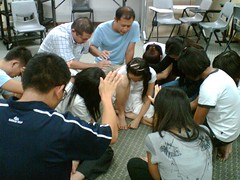
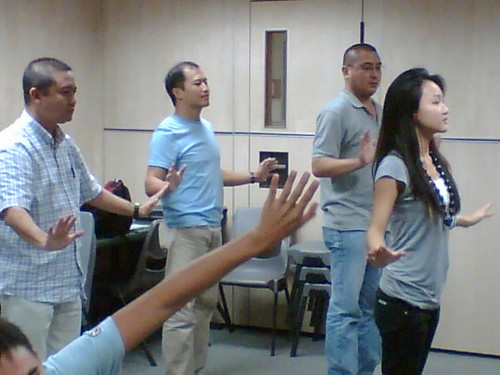
Trying out Diamond Ensemble as Worship.
NOTE: no photos of glissandos or singing MAY THE MIND OF CHRIST (for obvious reasons)


Trying out Diamond Ensemble as Worship.
NOTE: no photos of glissandos or singing MAY THE MIND OF CHRIST (for obvious reasons)
Tuesday, August 29, 2006
Thursday, August 24, 2006
Welcome to the blog for the first round of AD100 PERFORMING ARTS! I hope you're here because you've decided to take this course and I look forward to getting to know you and teaching you in the coming weeks.
Here is a copy of the COURSE SYLLABUS
COURSE TITLE : AD100 PERFORMING ARTS
INSTRUCTOR : Kimberly Creasman
DURATION : 28 August to 24 November 2006
(all course assignments, worksheets and homework will be posted on this site).
An introductory course designed to acquaint the student with various performing arts used in Christian Ministry. A combination of lecture, video and live examples, class participation, performances, readings, and various excercises will be done in class. Wear comfortable clothing in which you can move easily.
1. A framework of knowledge and appreciation for performing arts used in ministry (various styles of theatre, and dance).
2. Opportunity to experience a variety of styles as a performer, and/or for use as a director in developing and leading performers.
3. Regular and faithful attendance is required at all sessions.
4. Complete all reading assignments and homework.
5. Active participation in class activities and discussions.
6. Course “Exam” (student’s choose one of the following):
1. Exam 40%
2. Assignments 40%
3. Class participation 10%
4. Class Attendance 10%
4. Extra Credit +5%
(for posting assignments to the blog by the due date. +5% for each assignment )
Pederson, Steve, Drama Ministry: Practical Help for Making Drama a Vital Part of Your Church, Grand Rapids, MI: Zondervan, 1999.
Collected sample scripts, articles and vocabulary lists from the instructor.
Here is a copy of the COURSE SYLLABUS
COURSE TITLE : AD100 PERFORMING ARTS
INSTRUCTOR : Kimberly Creasman
DURATION : 28 August to 24 November 2006
(all course assignments, worksheets and homework will be posted on this site).
Description
An introductory course designed to acquaint the student with various performing arts used in Christian Ministry. A combination of lecture, video and live examples, class participation, performances, readings, and various excercises will be done in class. Wear comfortable clothing in which you can move easily.
Objectives
This course is to provide:1. A framework of knowledge and appreciation for performing arts used in ministry (various styles of theatre, and dance).
2. Opportunity to experience a variety of styles as a performer, and/or for use as a director in developing and leading performers.
Requirements
1.Assignments:- •Reaction paper to chapter 1 & 2 of the textbook Drama Ministry, Steve Pederson (below). Due 5 September
- •Evaluation of 5 published scripts on Christian themes (evaluation form attached, Sketch Collections on reserve in the library) Due 26 September
- •100 pages of reading from the selected reading list. Review and Rection of a minimum: 300 words. Due 24 October
3. Regular and faithful attendance is required at all sessions.
4. Complete all reading assignments and homework.
5. Active participation in class activities and discussions.
6. Course “Exam” (student’s choose one of the following):
- an in class performance of an original piece that can somehow be used in ministry (up to 8 minutes, and may be done in a group of up to 3 people) Printed script due: 14 November, Performance on either 14 or 21 November
- an oral and creative presentation of the content of one of the chapters from the selected reading list (minimum 5 minutes) Due: TBA
- a written reaction paper to an entire book from the selected reading list. Due: TBA
Grading
1. Exam 40%
2. Assignments 40%
3. Class participation 10%
4. Class Attendance 10%
4. Extra Credit +5%
(for posting assignments to the blog by the due date. +5% for each assignment )
Course Materials
Pederson, Steve, Drama Ministry: Practical Help for Making Drama a Vital Part of Your Church, Grand Rapids, MI: Zondervan, 1999.
Collected sample scripts, articles and vocabulary lists from the instructor.
Thursday, August 17, 2006
First Assignment: Due September 5
(second night of class we'll be discussing it)
After reading the Forward and Chapter 1 & 2 of DRAMA MINISTRY, by Steve Pederson, comment by quoting a passage that made you say, "YES! I AGREE!" or "OH, I never thought of it like that." (at least 1 sentence)
Then, respond to at least 4 of the following questions:
You can copy and paste this section below into your "comment" and edit from there, or first copy and paste into a word processing document on your computer to be placed as a comment when you've finished and saved your work on your computer.
CHAPTER 1
1. What did you learn about the history of theatre & the church. Would you like to know more about it?
2. After reading this chapeter, what are your thoughts about "entertainment" in the church?
3. Do you have a personal example of the power of drama to break down personal defenses? Tell us about it.
4. Do you feel that most believers are vulnerable and seeking to understand God and themselves when worshipping at church? What can be done to break down our defenses and get our whole selves more fully involved in worship?
5. Why does Willow Creek Community Church use contemporary sketches rather than Biblical sketches? Have you ever seen a sketch in worship that didn't "share the gospel?" What are your opinions about the Willow Creek philosophy?
CHAPTER 2
6. Do you agree that drama seems the "easiest" of the arts. Why?
7. What happens to the audience when watching a well done drama. Why?
8. Have you ever sought feedback or critique of your dramatic work. Did it help you? How? Why do people resist or not seek feedback? Complete this sentence: "A critique session is helpful only when you come away with some understanding of ________ ________ ___ ___________ ."
9. What does Steve Pederson mean by "Abusing the Art Form"?
10. How does the author describe Melodrama?
11. Do you agree that churches "hide" from the downside of life? Would you say that most churches are "addicted to playing it safe." What has been your personal experience with this?
12. What is your opinion of the "Less is More" concept?
(second night of class we'll be discussing it)
After reading the Forward and Chapter 1 & 2 of DRAMA MINISTRY, by Steve Pederson, comment by quoting a passage that made you say, "YES! I AGREE!" or "OH, I never thought of it like that." (at least 1 sentence)
Then, respond to at least 4 of the following questions:
You can copy and paste this section below into your "comment" and edit from there, or first copy and paste into a word processing document on your computer to be placed as a comment when you've finished and saved your work on your computer.
CHAPTER 1
1. What did you learn about the history of theatre & the church. Would you like to know more about it?
2. After reading this chapeter, what are your thoughts about "entertainment" in the church?
3. Do you have a personal example of the power of drama to break down personal defenses? Tell us about it.
4. Do you feel that most believers are vulnerable and seeking to understand God and themselves when worshipping at church? What can be done to break down our defenses and get our whole selves more fully involved in worship?
5. Why does Willow Creek Community Church use contemporary sketches rather than Biblical sketches? Have you ever seen a sketch in worship that didn't "share the gospel?" What are your opinions about the Willow Creek philosophy?
CHAPTER 2
6. Do you agree that drama seems the "easiest" of the arts. Why?
7. What happens to the audience when watching a well done drama. Why?
8. Have you ever sought feedback or critique of your dramatic work. Did it help you? How? Why do people resist or not seek feedback? Complete this sentence: "A critique session is helpful only when you come away with some understanding of ________ ________ ___ ___________ ."
9. What does Steve Pederson mean by "Abusing the Art Form"?
10. How does the author describe Melodrama?
11. Do you agree that churches "hide" from the downside of life? Would you say that most churches are "addicted to playing it safe." What has been your personal experience with this?
12. What is your opinion of the "Less is More" concept?
Monday, August 14, 2006
Sketch Evaluation
In class you will be reading or seeing a number of examples of well written pieces. As part of your homework, you are asked to read and evaluate at least 5 additional sketches here on the blog. Sketch Collections are on reserve in the TCA library. You may submit your evaluations here on the blog (preferred), or you may submit them in class by the due date (see Syllabus below).
How to submit here on line: Copy and paste the text below into a new document on your computer (so that your work doesn't get lost if you have trouble posting, and so that you have a copy of it in your computer). When you have finished responding to the questions below, come back to the blog and post it as a group member (if you've joined) or as a comment (if you have not joined).
Name of Sketch:
Name of Sketch Collection/Book:
Publisher:
Copywrite date:
On a scale of 1-10, how would you rate this script?
Do you feel that it would work in your setting without modifications?
Do you feel it would work with minor modifications
(To honor copyright, it is best to check through the publisher about modifications)?
STYLE:
(Realistic Drama or Comedy, Farce, Reader’s Theatre, Radio Drama, Mime, Puppet Show, Clown, Stylized, Musical, Opera)
TARGET AUDIENCE:
(Christians, Unchurched, Children, Youth, Adults, a specific ethnic group)
PERFORMERS NEED TO BE:
Beginning, Intermediate, Advanced
STRUCTURE:
Does it grab your interest and make you want to see what happens? How?
Does it develop logically, so that the action can be followed? (inciting action, rising action, climax, denoument)
Does it reach a satisfying conclusion? How?
What is the playwright’s theme? (issue)
Is the premise believable? (what happens)
Does it have clear and adequat conflict? What is the conflict?
Does it appeal to the imagination?
If a comedy sketch, is it funny?
If a drama sketch, is it actually dramatic?
If a mime, are the stage directions clear?
If a reader's theatre, is it voiced well?
Is it developed in a fresh creative way or is it too predictable?
MESSAGE:
What is it about? What Christian truth does it reflect or set up teaching about?
Does it deal with one issue, or avoid trying to say too much for it's length?
Does it avoid answering its central question with platitudes and cliches?
Does it refrain from being too preachy?
Is it relevant?
PRODUCTION:
Are the playwright’s production notes adequate?
Is it possible to produce?
How to submit here on line: Copy and paste the text below into a new document on your computer (so that your work doesn't get lost if you have trouble posting, and so that you have a copy of it in your computer). When you have finished responding to the questions below, come back to the blog and post it as a group member (if you've joined) or as a comment (if you have not joined).
Name of Sketch:
Name of Sketch Collection/Book:
Publisher:
Copywrite date:
On a scale of 1-10, how would you rate this script?
Do you feel that it would work in your setting without modifications?
Do you feel it would work with minor modifications
(To honor copyright, it is best to check through the publisher about modifications)?
STYLE:
(Realistic Drama or Comedy, Farce, Reader’s Theatre, Radio Drama, Mime, Puppet Show, Clown, Stylized, Musical, Opera)
TARGET AUDIENCE:
(Christians, Unchurched, Children, Youth, Adults, a specific ethnic group)
PERFORMERS NEED TO BE:
Beginning, Intermediate, Advanced
STRUCTURE:
Does it grab your interest and make you want to see what happens? How?
Does it develop logically, so that the action can be followed? (inciting action, rising action, climax, denoument)
Does it reach a satisfying conclusion? How?
What is the playwright’s theme? (issue)
Is the premise believable? (what happens)
Does it have clear and adequat conflict? What is the conflict?
Does it appeal to the imagination?
If a comedy sketch, is it funny?
If a drama sketch, is it actually dramatic?
If a mime, are the stage directions clear?
If a reader's theatre, is it voiced well?
Is it developed in a fresh creative way or is it too predictable?
MESSAGE:
What is it about? What Christian truth does it reflect or set up teaching about?
Does it deal with one issue, or avoid trying to say too much for it's length?
Does it avoid answering its central question with platitudes and cliches?
Does it refrain from being too preachy?
Is it relevant?
PRODUCTION:
Are the playwright’s production notes adequate?
Is it possible to produce?
Subscribe to:
Posts (Atom)
